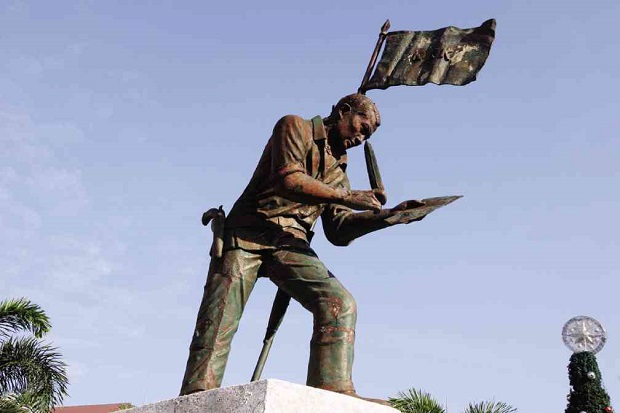Bonifacio for all Filipinos not just for poor

The Bonifacio sculpture stands in front of the Tutuban station: A historical distortion perpetuated even by the most esteemed historians. INQUIRER PHOTO
During formal commemorative rites at Liwasang Bonifacio on Nov. 30, 1997, the officials and guests of the mayor of Manila were rudely interrupted by National Artist Nick Joaquin who growled from his seat, asking “Where are the masses?”
Andres Bonifacio, after all, is known by many titles: Supremo of the Katipunan, the Great Plebeian, Hero of Tondo and Hero of the Masses. No wonder Joaquin snorted at the crowd in formal barong Tagalog and terno, roaring “Where are the masses?”
The flag-waving slogan-shouting activists were celebrating Bonifacio Day differently somewhere else.
One-hundred fifty-two years since Bonifacio’s birth, Filipinos should look back at textbook history to realize that Andres Bonifacio was not as dirt poor as we believe him to be.
Documents in the National Archives of the Philippines show that early in October 1896, during a lull in the outbreak of the Philippine Revolution against Spain, Governor-General Ramon Blanco ordered the assets of suspected Katipuneros frozen or seized. Andres Bonifacio’s name naturally cropped up in some documents that gave his home address as San Jose Street, Trozo, or the house of a certain “Capitan Quicoy” on Lavezares Street, San Nicolas, Binondo.
Nothing of value
But Bonifacio was nowhere to be found, and it seemed that there was not much of value to seize from the houses where he allegedly lived.
A year later, in October 1897, the Spanish colonial government ordered the Banco Español-Filipino (now BPI or the Bank of the Philippine Islands), and the Hongkong and Shanghai Banking Corp. (HSBC today) to freeze the assets of Andres Bonifacio. This had become moot by then since Bonifacio was executed in Maragondon some months earlier, on May 10, 1897.
But a certification dated Oct. 14, 1897, from Venancio Balbas, director of the Banco Español-Filipino read: “In reply to your communication dated the sixth [of October] received today, relating to the embargo of the assets of Andres Bonifacio and Candido Garcia, I state that none of these individuals have funds, nor stocks, nor shares, nor securities, nor credit in this bank.”
HSBC agent H. R. Coombs also issued a certification on Oct. 14, 1897, that read: “Hongkong Shanghay (sic) Banking Corporation, Manila. In answer to your communication of the sixth of this month received this afternoon, may we state that the individuals Andres Bonifacio and Candido Garcia do not have any kind of deposit in this establishment either in cash or stocks. We hope we have complied with your order.”
Aside from the above certificates, another document from the Administracion de la Hacienda Publica dated Oct. 20, 1897, stated that Andres Bonifacio, Juan Cuadras, Martin Ocampo, Alejandro Santiago, Modesto Español, Capitan Ramon and Candido Garcia “do not figure in our books as contributors.”
Doing fairly well
The documents showed that Bonifacio did not have a bank account nor any kind of documented assets and suggested that the Supremo was indeed as poor as most history books make him out to be.
But Espiridiona Bonifacio, smarting from the stereotyped image of her brother as a poor man, sought to correct that impression in a 1954 interview with writer Jose A. Quirino. “There is nothing wrong with being poor as I am now, but we were not poor as rats as pictured by some writers. Just because we made fans and canes does not mean we were destitute. In fact, the family business was doing fairly well and some of our best canes sold from P50 to P100 each.”
Much of the confusion regarding Bonifacio’s socioeconomic status stems from the fact that he is often depicted in art and monuments as wearing a white camisa chino and red pants, the usual attire of common folk in the late 19th century. To add to the stereotype, he is sometimes depicted barefoot. The different descriptions of his various jobs do not help any. Bonifacio has been described in some textbooks as a vendedor (salesman, peddler, retailer, hawker, sales clerk, etc.), a mandatorio (agent or attorney) and bodeguero (warehouse owner or grocer). Pio Valenzuela also added portero (caretaker, concierge, house manager or porter) to his previous jobs.
So depending on the book you’ve read, Bonifacio becomes either of these: a night watchman, warehouse keeper, agent, broker, attorney, sales agent, messenger, clerk and clerk-messenger!
Middle class
With the exception of “attorney” and “broker,” those jobs may seem lowly by today’s corporate standards. But in the late 19th century, these jobs—especially if they were with foreign trading companies—placed the employee closer to the middle, rather than the lower, class. Bonifacio first worked for Fleming & Co., an English trading firm, before moving to the German trading firm Fressel & Co.
If we were to believe Valenzuela, the Supremo of the Katipunan was described as: “astute and intelligent and spoke Tagalog fluently, and those who did not know him would not think he was a bodeguero.”
Nick Joaquin should not have expected the masses to be present at the celebration of Bonifacio Day; he should have looked for the middle class.
But then Nov. 30, Bonifacio Day, is a time to recall the life and deeds of the hero who sparked the Philippine Revolution against Spain that led to the birth of the nation. Bonifacio Day then is for all Filipinos, regardless of social class and ideological bent.
RELATED STORIES
Controversies over Bonifacio’s death




















